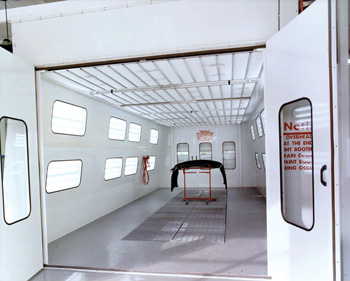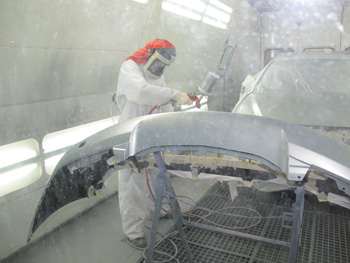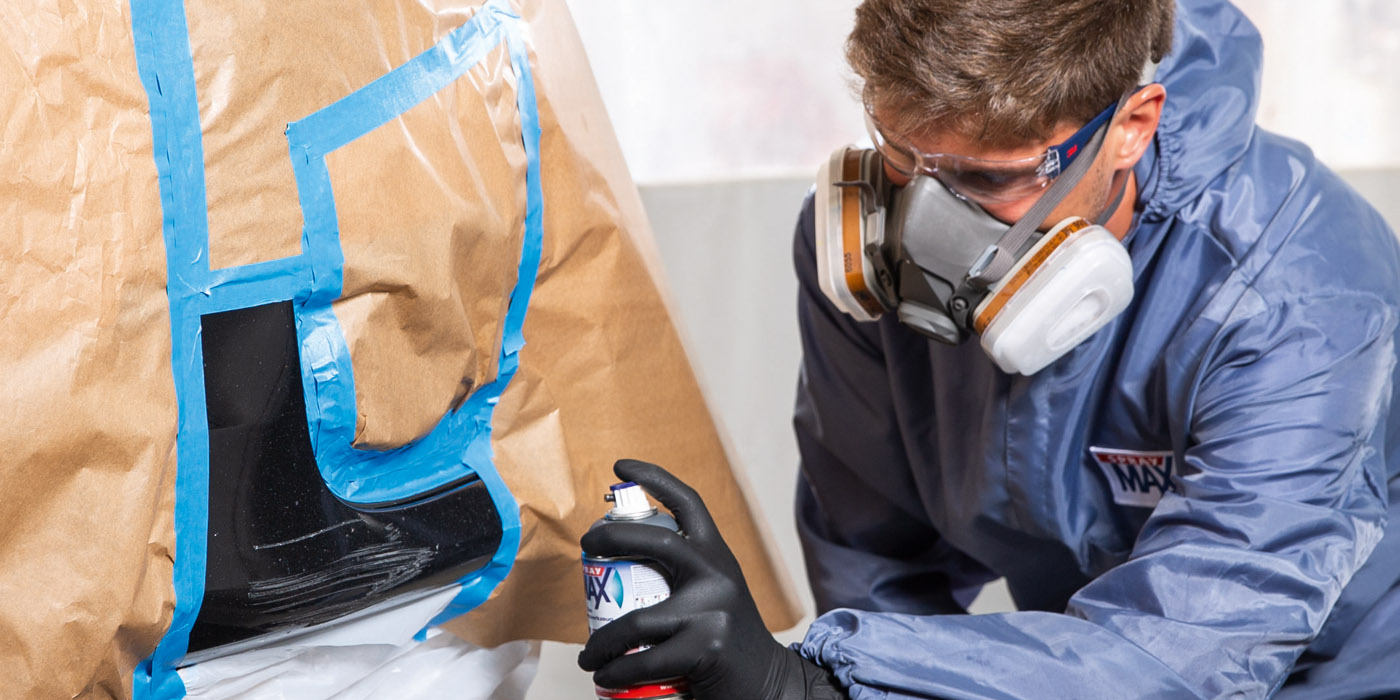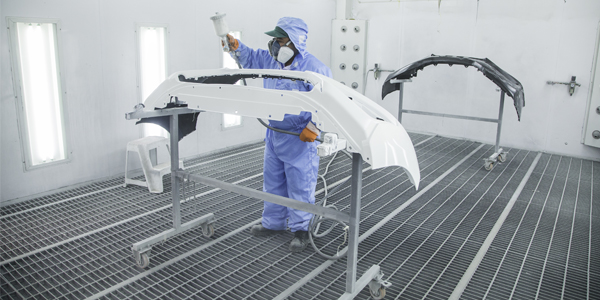 How high should the exhaust stack be above the building roof?
How high should the exhaust stack be above the building roof?
Answer provided by A-Frame Spray Booths: The exhaust stack height is controlled by local code. In general, the stack should extend a minimum of three feet above the peak of the building roof.
In some areas, the stack is required to be one and half times the building height. Also, it’s common for the stack to be required to terminate a minimum distance from the property boundary. Check local code.
How do you know when intake or exhaust filters should be changed?
Answer provided by Col-Met Auto Direct: Sounds simple enough, right? Not so much. There are many variables to consider when asking this question, such as:
- Environment: Is my shop very clean, moderately clean or on the dirty side?
- Volume: How many vehicles am I painting per day/week/month?
- Spray product: What am I spraying inside of my booth?
- Pressurization: Is my booth pressurized with an air make-up unit attached, or is it non-pressurized?
You could probably come up with even more variables, but these are the main ones to consider.
Let’s also separate the two types of filters inside the booth: intake filters and exhaust filters.
Booth manufacturers spend a lot of care in the design and functionality of the airflow to be productive and within the required guidelines. It’s important to use the recommended OEM filtration, which is generally made available by the company that sold you the booth. Having said that, there are a few generic guidelines you can follow:
- Intake filters: It’s fairly easy to see the inside of the intake filter. A good rule of thumb is to replace this filter when the inside becomes dirty or discolored. In an average shop that’s fairly clean, this can be done every two to four months or about every second to third time you replace your exhaust filters.
- Exhaust filters: The bad news is that you can’t really see the inside of an exhaust filter. The good news is that most paint booths come with a handy device called a manometer. This device has a visual indicator that displays the “load” on your exhaust filters. Once the manometer has been properly balanced prior to using the booth, it can show you the progression of the contaminants building up or “loading” the filters. A good rule of thumb is that you want to change these filters when the load reaches about a half-inch. In an average “one-car-a-day” shop, this can be done typically every two to four weeks.
How does an insulated booth differ from a single-wall unit?
Answer provided by UniCure: A double-wall booth is constructed of two layers of sheet metal with a layer of insulation in between. The insulation is usually a rockwool or similar product. A single-wall booth is constructed of a single layer of sheet metal at a heavier gauge and doesn’t have a layer of insulation. The main difference between a double-wall booth and a single-wall booth is price and cosmetics. The smooth exterior of a double-wall booth looks great, but you will usually pay a premium for those looks. There are some additional features such as inside accessible light fixtures, but those can be added to a single-wall booth as well. When it comes to function, there is little advantage to a double-wall booth over a single-wall.
The air makeup and mechanical systems can be exactly the same on either style of cabin. Both units can have spray and bake capabilities with the same performance. A single-wall booth can also have the same efficiency as a double-wall. The insulated panels of a double-wall do not retain significantly more heat than non-insulated panels. Air in a spraybooth is moving so fast that the heat transfer rate from the air to the booth walls is low. The greater benefit to retaining heat and increasing metal temperatures of the painted surface during bake mode is the proper pressure in the cabin. This is why it’s more important to focus on the air flow and control systems of a spraybooth instead of the cabin style. As a spraybooth manufacturer with U.S.-made single-wall and double-wall booths, we offer both products, but the single-wall booth is the workhorse of the industry.
Where should the lights be located? What type of bulbs are best?
Answer provided by Global Finishing Solutions: Proper lighting is absolutely crucial to achieving a perfect finish. You want to ensure that you have enough overlap of all the light generated in the cabin so that no matter where the painter is standing, the shadows that would be created by the light directly behind them is eliminated by the other lights in the booth. The best arrangement for lights in a spraybooth is a combination of angled lights in the ceiling and vertical lights in the sidewalls. The lights in the ceiling illuminate the top surfaces of the vehicle, while the vertical sidewall lights illuminate the sides and lower areas. The reason we recommend vertical lights in the walls instead of horizontal is that they provide the greatest spread of light across the sides of the vehicle from top to bottom.
Horizontally-oriented lights concentrate on the center of the vehicle, but don’t spread enough light above and below to ensure complete illumination. Vertically-oriented lights provide greater coverage of lower surfaces, and achieve better overlap to eliminate shadows as the painter passes in front of them. We tend to rely primarily on T-8 color-corrected fluorescent light tubes for the best possible balance between energy-efficiency and light spread. T-12 light tubes are not nearly as energy-efficient as their T-8 counterparts and don’t produce as much light, and so are generally accepted as inferior light tubes for spraybooth applications. T-5 tubes tend to produce a more “concentrated” pattern of light that is ideal at greater distances, but when placed inside a spraybooth, we’ve found that the distance between the walls and the vehicle is not sufficient to get the optimum spread of light. T-8 tubes hit the “sweet spot” of providing a great spread of color-corrected light at the perfect distance and consume little energy.
What fuel gas pressure/volume does your air replacement need?
Answer provided by Spray-Tech: The type of fuel depends on what’s available. In most metropolitan areas, natural gas is the fuel of choice because of availability. When adding air makeup to a building, additional load becomes necessary. Piping from the street and upsizing the meter may become additional expenses. However, in most metro areas, natural gas is the most economical fuel choice. In rural areas, connecting to natural gas may be cost prohibitive or not even an option. Liquefied petroleum gas (LPG) or propane work best, and a great supplier can be an asset. When using LPG in colder climates, use a vaporizer to prevent liquid propane from reaching the burner manifold in the air makeup unit.
Most air makeup units work between 7 and 21 inches of water column pressure using natural gas and 11 inches using propane. Pressure has an impact on the operating characteristics of the air makeup units’ burner manifolds, and usually a dynamic pressure reading is used to determine low and high fire settings to provide a clean burning system.
A system’s volume will be determined by the air makeup’s BTUH rating. Volume is the amount of cubic feet of fuel delivered to the air makeup to generate the temperature rise desired. This will vary according to the system’s location and the nominal temperature recordings for a calendar year in that particular location. The correct volume delivered to a system is impacted by the fuel’s piping system and must be calculated to assure proper fuel capacity and delivery. A licensed professional contractor, architect or propane fuel supplier can make these calculations and assure proper volume delivery.
How many different types of fans are there for spraybooths?
Answer provided by Garmat: Fan selection is crucial to spraybooth performance. The design differences have a major impact on the stability and consistency of air flow, the useful life of the filter, and the long-term durability of the motor and bearings.
Axial fans are designed to move high volumes of air. Tube axial fans are the typical axial fan designs used in spraybooth applications. They’re generally chosen for their low price point, not necessarily for their effectiveness. They’re sensitive to changes in static pressure, or the resistance to air movement. As filters load, the capacity of the fan diminishes quickly.
Centrifugal fans accelerate air radically by changing the direction of the air flow. They’re quiet, reliable and capable of operating over a wide range of conditions. There are several types, but the three most efficient designs include forward curve, reverse incline and airfoil reverse incline fans.
Forward curve fans are the most efficient for a given set of conditions, such as HP, size and initial static pressure. Prone to collecting overspray, these fans are best used on the supply side and are not recommended for use in exhaust applications.
The reverse incline fan uses blades that curve against the direction of the fan wheel. The blade’s reverse direction creates a vacuum of air that surrounds the blades, reducing overspray buildup. These fans are highly resistant to static pressure, and provide more consistent air flow as the filters load.
The airfoil reverse incline fan is the most efficient of all the centrifugal fan designs for exhausting air. The airfoil design of the blade allows the fan to run at a higher speed more efficiently, and with less noise, than the typical reverse incline, while still offering the benefits of the reverse incline fan.
 If I buy a brand-new booth, will I have to retrofit it for waterborne?
If I buy a brand-new booth, will I have to retrofit it for waterborne?
Answer provided by Accudraft: It depends. Be aware of what you’re buying because all booths are not the same. While doing research is great, nothing beats talking to an experienced and qualified salesperson. They should be able to point out the differences and benefits for each model the booth manufacturer offers and whether a model is waterborne ready. The salesperson will also be able to speak intelligently about the overall cost per model, which is where most decisions will be swayed one way or the other.
Many manufacturers offer out-of-the-box booths that are ready for waterborne paint. Some are high-powered downdraft booths with extra large air makeup systems, while others come with auxiliary air systems such as air jets or ceiling fans already installed. If you’re looking for waterborne capability now, make sure the system is one of the latter.
High-powered downdrafts dry waterborne paint quickly and maintain the cleanest environment possible by maintaining the downdraft air envelope and pulling any contaminants downward. Auxiliary air movement systems dry waterborne paint the fastest, but must be maintained and kept clean so as not to stir up dirt or debris. Both offer great results and should be discussed with your paint professionals and the booth salesperson.
There are many factors unique to each shop that may make one of the two booths discussed a better recommendation. Paint companies are continually improving the chemistry and technology behind the coatings and know what’s needed to dry their product. The booth should meet the paint brand’s minimum requirements for heat and air flow. Once you have matched what your paint rep or jobber is recommending for the booth model that best suits you, you should be able to make a more informed decision.
Waterborne paint is the future, so keep that in mind regardless of what you buy. Make sure the system is ready for water out of the box or can be easily converted in the future. Ask what the manufacturer’s waterborne add-on system is and how much the complete system and installation is going to cost when you’re ready to switch.













